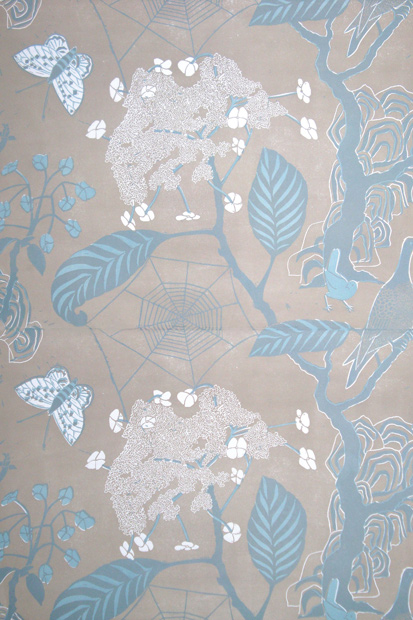Every night, while my husband reads by screen-light, my mind runs like an invisible rat two miles north to the house we’re rebuilding in Islington. And there it scurries from room to room, around the rotten skirting boards, up walls, into corners: testing, considering, fretting. Carpets or wooden boards? Which doorknobs, latches, hinges? Which white for the walls? What will look best, and what (hang your head, o rat) will your friends envy and admire?
Towards 1 a.m., the rat gets ideas, starts thinking: hmm, polished concrete floors? Maybe a hot tub? And I hear my mother’s voice: Oh darling, no. That won’t do.
Tiles, mirrors, rails, plugs. Only once in the hotchpotch of endless decisions and revisions have I discovered something so lovely that the rat stopped in its tracks. This lovely thing is a wallpaper my mother found. It’s handmade paper, designed and printed by a woman called Marthe Armitage, and if I never in my life thought I’d write in praise of wallpaper, I never knew either how beautiful and calming wallpaper could be.
Marthe’s a painter who studied at the Chelsea School of Art after the war, and turned to printing in the 1960s when her children were young as a way of doing quicker, less involving work. She’d push her pram along the Thames in Chiswick and take inspiration from things she saw along the way: cow parsley, oak leaves, seed pods. Then she drew out her designs on paper, cut them into big blocks of lino and printed them using an old lithographic proofing press she’d picked up secondhand.
I visited Marthe’s studio in Chiswick last month to order my wallpaper. Up a stone stair into a smallish studio space with a view over rooftops to the broad, grey Thames. Marthe fanned out a selection of her papers on a desk and there was illustrated the land of her imagination: trees, birds, cobwebs, snails in greys and pale greens; mustard and faded pink. Pagodas, peasants, palaces, roses, saints and horses. They weren’t just charming or even lovely, but magical. I chose jungle birds and cobwebs but greedily wanted all of them and still mourn the ones I left behind.
As we descended the stone steps, Marthe talked about her work. She hadn’t realised until recently, she said, how important it is to make things by hand. Her designs appear not before, but as she draws — in that weird semi-conscious state in which good art is made. Most other wallpapers these days are designed on computer in an instant. No wonder wallpaper magic is rare.
Half a century after Marthe first began, she’s still printing by hand on that same old press she’s always used. Her daughter helps now, because Marthe’s over 80 and also because there’s an awful lot more to print these days. She’s become sought-after in her old age (in the best way, by word of mouth) and the rich and famous are hungry for her designs. This makes her pricey, but there’s an upside: it makes the world seem brighter, somehow, to think that the corridors of power are papered in Marthe Armitage.







Comments